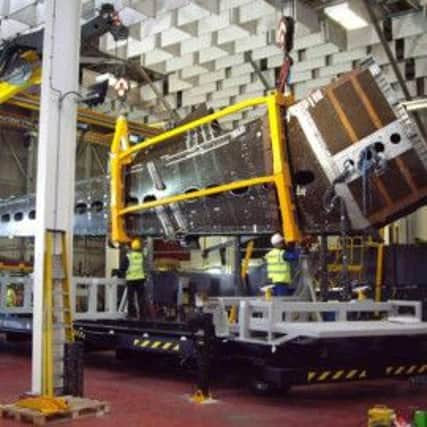Chair of MPE board helped secure CSeries work


Michael J. Ryan, General Manager of Bombardier Aerospace, Belfast, accompanied Pierre Beadoin, President of its Québécois parent firm, to a meeting with the then Investment Minister Nigel Dodds in 2008 to help seal a deal that resulted in wings and nacelles for the company’s CSeries jets being made in Northern Ireland.
According to a briefing document prepared by Invest NI’s Transport, Construction and Tourism division Bombardier is aiming to sell a minimum of 1,770 aircraft, which represents approximately 30 per share of a market estimated at 5,900 units over the life of the programme, which will last for 20 years.
Advertisement
Hide AdAdvertisement
Hide AdLocal engineering firms such as MPE are well-placed to benefit from the massive programme and has already secured orders for a CSeries contract, according to Managing Director Sean Phelan in a statement to local media recently.
A Bombardier organisation chart dating from 2008 also shows that the aerospace giant has a 35 per cent interest in the Maydown company.
According to a further Invest NI briefing document global market forecasts predict 6,700 new aircraft in the 100 to 150 seat segment over the next 20 years.
“Based on estimated average aircraft prices, the total market potential is roughly 393billion dollars,” the document states.
Advertisement
Hide AdAdvertisement
Hide AdUnfortunately, protectionism has hampered Bombardier’s attempts to secure buyers in the United States.
Another internal memo from Invest NI’s Transport, Construction and Tourism Division to Mrs Foster ahead of St Patrick’s Day visits to the United States in 2011 said Boeing wasn’t keen on the competition.
“There has been significant resistance within the US towards the entry of Bombardier’s CSeries aircraft into the lower end of the commercial aircraft market, which is primarily served by Boeing and Airbus aircraft, particularly B737s and A319s/A320s,” the memo states.
It claims the situation in 2010 was “quite serious” and “although there is greater recognition within the United States that the CSeries will bring significant economic benefits to the US through the supply chain, there is still some scepticism that the CSeries will displace some of Boeing’s market share, particularly in the 100-150 seat segment.”
Advertisement
Hide AdAdvertisement
Hide AdInvest NI’s aerospace experts, however, stated that Boeing’s aircraft in the 100-150 seat market were operating at a “sub-optimised” level.
“They are carrying less passengers than the aircraft were designed for and, therefore, the seat cost per passenger mile is higher than will be the case with the CSeries, which will be optimised for this market segment,” the document reads.
In an interesting aside another document reveals that Mr Dodds’ successor, Arlene Foster dismissed concerns about the fuel efficiency of the CSeries engines and said that besides, it would be too late to change flight path at this late stage.
The First Minister Peter Robinson passed on an email he received on March 2, 2010 - the identity of the emailer is redacted - to his party and Executive colleague.
Advertisement
Hide AdAdvertisement
Hide AdThe correspondent claimed to have spoken to engineers at the Shorts Brothers factory in Belfast.
The email reads: “Even with the geared turbine engines, the price of aviation gas will make even the CSeries too fuel greedy for short haul in the future.
“They see the future in turboprop engines and the CSeries should also be researching mounting propfans.
“These would have to be mounted on the wing, so perhaps the easiest way to research this installation would be to investigate mounting the current choice of engine but over-wing.
Advertisement
Hide AdAdvertisement
Hide Ad“Over-wing costs more, but gives added lift and reduces risk of debris damage to engine. They’ve spoken to me because they don’t trust the strategy of Bombardier.
“Can you do anything to ensure that some of the Research and Development (R&D) goes to researching alternative engines?”
After Mr Robinson passed on the message, Mrs Foster replied that the current engines had been chosen early in the CSeries’ development.
She wrote on April 10, 2010, that the choice of the geared turbofan engine - a Pratt and Whitney machine - had been made after careful consideration of the optimal requirements for the aircraft.
Advertisement
Hide AdAdvertisement
Hide Ad“In Northern Ireland, Bombardier is undertaking the design, development and manufacture of the wings for the CSeries, This is a major inward investment; the largest ever secured for this region, and represents an investment commitment of £520million by Bombardier,” she wrote.
“The UK Government has agreed to provide £113million in repayable Launch Investment and £21 million in Selective Financial Assistance towards the wing project in Northern Ireland.
“The development of the engine solution is taking place In North America. As the CSeries programme is already at an advanced stage of development, with entry into service planned for 2013 and Bombardier has already made its decision on the choice of an engine for the aircraft, there is no scope for the engine technology to be re-evaluated at this stage.”